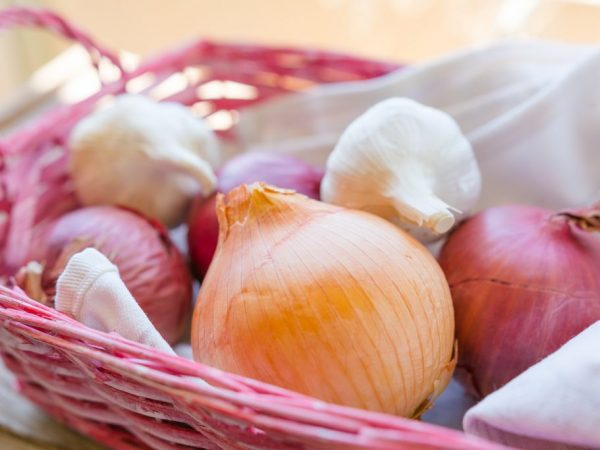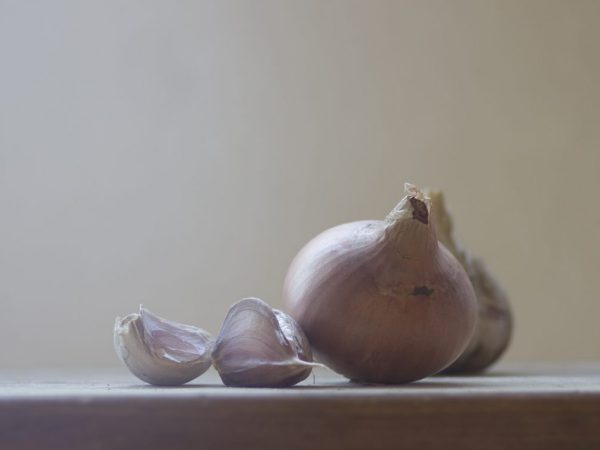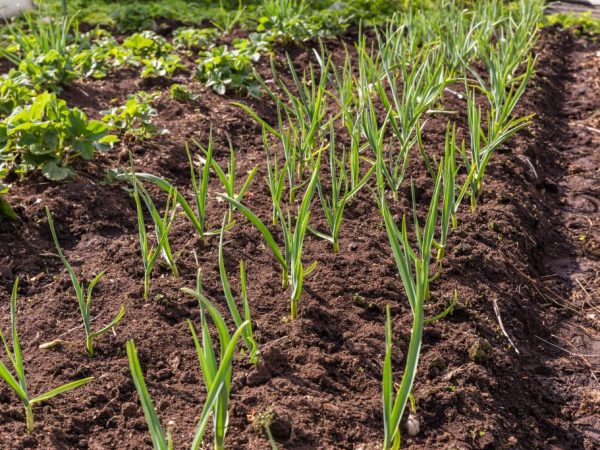Top dressing for garlic and onions
Growing a garlic crop on a personal plot is impossible without fertilizing. Garlic dressing is carried out at different periods, by different means and methods, how to feed garlic and how to fertilize onions, and with different dosages.

Top dressing for garlic and onions
What is top dressing for?
The entire garlic culture is divided into two varieties according to the growing season:
- winter crops, which are planted in the fall for the winter, getting an early harvest,
- spring, which is planted in the spring, when the soil warms up.
Both types require recharge, which is required to be made within a certain time frame. For the crops planted for the winter, the timely application of mineral fertilizer for garlic and onions ensures the normal development and growth of the plant. When these crops are fertilized, they receive all the mineral nutrients they need to grow a good harvest.
In the spring, it is necessary to feed the winter garlic crop by feeding for a simple reason. After the experienced winter season, it provides replenishment of the energy expended by the plant, so that in the coming months there is a rich harvest with large heads.
Spring feeding is also important for the spring type, since fertilizers for this species are the key to the timely formation of garlic bulbs. In addition to spring, for spring and winter crops, they also give summer feed in order to increase the plant's resistance to diseases and pests.
What kind of soil is suitable
Experienced summer residents have long known that a good earthen bed with neutral acidity and fertility is important to obtain a large garlic harvest.
Acidity
The neutral acidity of the soil, on which the crop shows the best results, growing with large heads, is the key to the future harvest. The soil in the garden, acidic in composition, is alkalized before planting the garlic culture. This can be done by adding lime - fluff, which is added at the rate of 2-3 kg per 1 square meter of sown area.
Some people use wood ash instead of lime before planting in the garden. Its amount is calculated according to the initial indicators of soil acidity and can vary from 0.7 to 3.0 kg per 1 square meter of sown area.
Manure application
For a plant that is demanding on soil fertility, it is imperative to feed the land with fresh mullein or manure (horse, sheep, pork). Manure with mullein is introduced only under the previous garlic culture, only then it will become useful. Fertilizing soil with any form of manure during the growing season can delay the growing season and adversely affect yields. The number of sown area per 1 square meter is about 7-10 kg.
Soil additives
For different types of soil, in order to increase soil fertility when growing a garlic crop, it is recommended to feed the soil with soil additives:
- in heavy clay soil per 1 square meter of sown area, at least 10-liter bucket of sand and the same amount of peat are introduced,
- a ten-liter bucket of peat component mixed with a bucket of powdered clay is added to light sandstones and sandy loam soil,
- in swampy peat areas, sand and loam are used in the same amounts.
Autumn fertilizers

It is worth feeding immediately after planting.
The first feeding of winter garlic is carried out in the fall. The initial application is done before planting the garlic culture, 1-2 weeks. Humus acts as the main means of feeding, than feeding garlic in the autumn period, 10 liters by volume of which is mixed with 1 large spoonful of superphosphate, 2 large tablespoons of potassium sulfate and 0.5 liters of wood ash.
Winter garlic especially loves such fertilizers, which include wood ash, and if it is timely applied to the soil, natural wood ash for garlic and onion can provide good yields in the future.
Experienced gardeners do not make feeds in the fall, containing nitrogen among the components, which contributes to an increase in the growth activity of the leaf rosette and the root system.
Gardener Tips
Experienced summer residents in the fall try to feed the winter type with manure at the rate of 5-6 kg per 1 square meter of sown area. Instead, you can use a peat-manure compost composition, the volume of which for the same area is from 8 to 10 kg. Garden compost for this purpose requires a little more - an average of 11 kg. All these fertilizers for garlic, applied in the fall as a top dressing for winter crops, will result in large bulbs in the fall.
As noted earlier, nitrogen-containing compositions are not introduced at all, or it is better not to abuse them, since they give an impetus for the development of feathers and arrows.
Spring fertilizers
Upon the arrival of spring, winter crops germinate and need planned feeding to restore the energy spent on wintering. Feeding for the spring is carried out later, at the stage when the plant goes to active growth and begins to form an ovary.
Most often, they try to add the garlic feed when they begin to water the plants. This joint care is carried out to avoid excessive overflow. You can water the plant already, starting at the end of spring.
Initial feeding
The first introduction of nutrient compositions for winter and spring garlic crops is carried out with urea, which is diluted in a proportion of 1 large spoonful of the drug to 1 ten-liter bucket of water. For 1 sq.m. the sown area requires 2-3 liters of working fluid with urea.
In the primary feeding among the means, than feeding onions and garlic, feeding with urea is the main one.
Secondary feeding
The second dressing of garlic in the spring is carried out a couple of weeks after the initial one. The use of the second feed, as well as the first, is the same for both spring and winter garlic crops. The main components during this period are working fluids with ammonia, nitrophoska and nitroammophoska. Preparations are diluted in two large spoons per bucket of water. The consumption rate of the finished working fluid is about 3-4 liters.
Summer fertilizers

You can process it with ready-made and folk remedies
Top dressing in summer is the third application of nutrient formulations, which is planned for mid or late July. This is the time for the garlic bulbs to form, which require additional nutrients. Most often, the third fertilizer for onions and garlic is used for the spring type, but sometimes it is applied for winter crops that ripen much earlier.
The third dressing of garlic, the last, requires gardeners to comply with its deadlines.Fertilizers applied earlier than the due date lead to the waste of the plant all the energy on the arrows and greens. The late fertilizer for garlic, when its leaves are already turning yellow, becomes a waste of time.
Superphosphate
As food for the full formation of garlic heads, among the main nutrients, how to feed garlic are potassium and phosphorus, for which gardeners are actively using superphosphate. The drug is required, two large spoons per 10 liters of water. The consumption rate of garlic fertilization is on average 4-5 liters of ready-made working fluid with superphosphate per 1 square meter of sown area.
Foliar fertilizers
Experienced gardeners in the summer actively use the foliar feeding of the garlic culture, especially when the leaves turn yellow. It acts as a complementary tool. Garlic foliar fertilization is used when you need to quickly and urgently give the plant food. Foliar feeding of garlic, when the leaves turn yellow, better and faster allows you to assimilate nutrients.
Urea and boric acid are well suited for foliar spraying. This is an important recharge, which gives impetus to the development of new ovaries.
The use of spraying a plant with foliar dressing after removing yellowed foliage is required in the evening. It is correct to spray with mineral compositions twice a summer during the period of active development of the garlic culture.
Folk remedies
In the people, hydrogen peroxide, yeast, salt and iodine are widely used for spraying the garlic plant in the summer, which are more growth stimulants than fertilizers.
Hydrogen peroxide
Its main purpose is to remove microorganisms, and gardeners began to effectively use this property of hydrogen peroxide to nourish vegetable crops and stimulate their development at the stage of active growth. The preparation containing atomic oxygen is able to saturate the soil with an oxygen component, which favorably affects the growth of the garlic culture. For watering with hydrogen peroxide, two large spoons of its 3% composition are diluted in a liter volume of water. Water the plants with this working fluid immediately after the first shoots appear at the beginning of the spring season. However, many gardeners use hydrogen peroxide to water already mature plants, giving them the necessary nutrition during the period of active growth.
Yeast feed
Yeast solutions increase the formation of the root system and lead to an increase in the plant's resistance to disease. When introduced into soil, yeast has a beneficial effect on the activity of bacteria that actively process organic matter and thereby fertilize the soil.
Iodine
Replenishment with iodine makes the soil more fertile and activates the development of plants. It is especially important for peat and podzolic soil soils. Solutions with iodine are made at the rate of 40 drops of a medical alcohol solution with a concentration of 5% per water volume of 10 liters. Most often, iodine working fluids are used as foliar feed up to the stage of ovary formation. During the formation of the ovary, vegetable crops are watered with an iodine solution mixed with hydrogen peroxide.
Salt
Experienced summer residents use salt liquids for watering onion and garlic crops in the spring, when an onion or garlic feather grows approximately 10 cm high. Such watering is carried out twice, with a time interval of 10 days. For the salted liquid, place 3 large spoons per bucket. Some gardeners increase the salt concentration to a glass. Saline solutions used for watering have a detrimental effect on pests and at the same time activate plant growth during the formation of bulbs.
Mineral compositions
Among the complex fertilizers that are intended for growing onion and garlic crops at the same time, gardeners are well aware of several:
- a granular complex from the manufacturer called Fasco, containing magnesium with calcium. Consumption rate per 1 square meter of area - 100gr; often, the complex mineral composition with magnesium and calcium from Fasco is used not only during the summer nutrition of vegetable crops grown in the garden, but also as an effective means for preparing the soil before planting them,
- a complex mineral composition similar to the previous one called "Tsybulya" has the same effective methods of action and acts as a full-fledged feed in the cultivation of onion and garlic crops; the consumption rate of this drug is about 80 g per 1 sq. m. sown area,
- A water-soluble nutrient complex called Agricola has established itself among gardeners due to its convenient use, it can be added during the preparatory pre-planting work, but many people prefer to use the mineral preparation in a diluted form, diluting every 25g in a ten-liter bucket of water, sometimes increasing the water volume to 15 liters.


